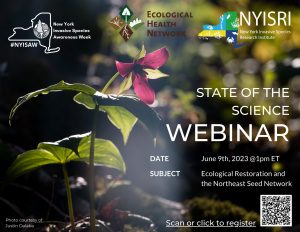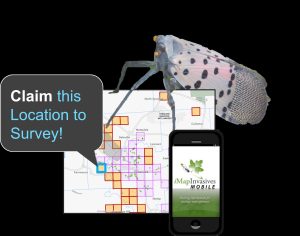From fair staples like the common goldfish to exotic armored catfish, learn how aquarium residents and plants can harm our native ecosystems. We’ll go over aquarium releases in the U.S., here in NY, and their impacts on the environment. We’ll also cover what to do when goldie outgrows its tank and what to do with an overabundance of plants or unwanted fishes.
Zoom link: https://us02web.zoom.us/j/84693570365
Tired of having to mow a bunch of grass in your lawn all summer? Want to make your lawn a hotspot for diversity and pollinators? If yes, join Kristopher Williams of the Capital Region PRISM for a webinar about the benefits of pollinator gardens, how to know which native species to plant, and steps you can take to transition from a grass lawn and restore pollinator habitat.
Salamanders are one of the most important organisms that call New York home, playing significant roles in the food web, nutrient cycling, and more. Unfortunately, American salamanders face a new threat – Bsal (Batrachochytrium salamandrivorans). Bsal is a fungal disease that has had extraordinary impacts on salamanders and Europe and if it arrived in North America would have as large of an impact on our ecosystems as the chestnut blight or white nose syndrome. Learn how Bsal could affect our salamander populations, why this matters, and tools and strategies we can use to protect our salamanders and prevent Bsal’s introduction to North America.
Webinar link: https://hws.zoom.us/j/93034689217
During this years New York Invasive Species Awareness Week (NYISAW), learn how you can record and submit data to iMapInvasives, the official invasive species database of New York State. Training will include background of iMapInvasives, how to create an account, and how to submit invasive species data using the website or mobile app.
This virtual workshop will explore the art of storytelling and how to frame invasive species language in a way that reduces cultural biases, racism, and exclusionary concepts. Interactive ad-lib style activities will be incorporated to engage the audience and have fun with this concept! This webinar will be catered toward professionals, but is open to anyone interested! Register here: https://tnc.zoom.us/meeting/register/tJElc-msqjovH9LNMbtONG4DlQxvJAegaFAk#/registration
Join the New York Invasive Species Research Institute and Ecological Health Network for a State of the Science webinar around the topic of native plant restoration in the Northeast. Featured speakers will include James Aronson and Eve Allen of the Ecological Health Network. James Aronson is a long-time restoration practitioner with four decades of experience in the field, is a Co-Founder of the Ecological Health Network and Emeritus senior scientist at Missouri Botanical Garden. His presentation will cover an overview of where holistic ecological restoration intersects with global efforts to remove and reduce biological invaders with a special focus on the Northeast U.S. and adjacent bioregions south and north. Eve Allen is the Program Director of Northeast Initiatives at Ecological Health Network, where they are working to advance the science and practice of ecological restoration. Eve’s presentation will cover an integrative network approach that is generating solutions to commercial shortages of native seeds to create biodiverse, self-sustaining plant communities. The New York Invasive Species Research Institute is excited to bring together expertise on this topic and discuss a potential path forward to restoration challenges.
Register here: https://cornell.zoom.us/webinar/register/WN_pra6lyfBQwi9VpR4RNWF5w
Join the Adirondack Park Invasive Plant Program for a free workshop on photography and invasive species. The event is being held as part of New York’s Invasive Species Awareness Week.
This webinar is for anyone who is looking to get into or increase their existing knowledge of photography. The material is excellent for beginners who want to gain a deeper understanding of how to use manual settings and compose better images, and it will also provide a detailed overview of how to look for, photograph, and report invasive species.
“Photography for Nature Lovers” attendees will learn the following:
Photography basics, including how to understand f-stop, ISO, and shutter speed
Composing an image using concepts like the Rule of Thirds and the Fibonacci spiral
Tips on using photography to tell a story
How to photograph a species for identification purposes
How to identify some common invasive species
How to use iMap Invasives, New York’s invasives species database, to report invasive species
Learn how to survey for invasive spotted lanternfly (SLF), and it’s preferred host, tree-of-heaven (ToH) from experts at the NYS Department of Agriculture and Markets, and how to report your findings to New York’s official invasive species database.
New York is looking for people like you to join a collaborative network of volunteers and professional scientists monitoring the spread of this invasive insect, and reporting surveys in iMapInvasives. Visit www.nyimapinvasives.org/slf for more information.
Event link: https://meetny.webex.com/weblink/register/rad08ea844bb86aff4c636f325149919f
Presented by Andrea Locke, WNY PRISM Coordinator
Learn about the common Pathways of Invasion and how this knowledge can be put to use in order help stop them in their tracks! Whether you are looking to manage invasive species on a landscape scale, across a hundred-acre preserve or in your own backyard, understanding how invasive species are introduced and spread is a key to being successful. From human-aided pathways, such as hitchhiking forest pests, to natural spread mechanisms, such as windblown seed, there are steps all of us can take to disrupt these pathways, prevent the spread and pledge to protect our lands and waters.
This event is part of the New York Invasive Species Awareness Week (NYISAW) 2023 Webinar Series.
Register here: https://forms.gle/vGWCX1YeJyYLLnDi6. Questions? Email WNY PRISM at wnyprism@buffalostate.edu.
Join the Long Island Invasive Species Management Area (LIISMA) to dive into the identification of native and invasive plants and animals that you may encounter at your local waterbodies. On this interactive virtual lake survey, you will learn what goes into an aquatic survey and how you can do your part to prevent and report invasive species. This is a beginner-friendly webinar great for kids, families, and all ages!
Register here: https://us02web.zoom.us/meeting/register/tZcqc-2sqjkiH9zOwWupsNOVAa1gBiYmIhyu
Presented by:
Kassidy Robinson, LIISMA Education and Outreach Manager
Melody Penny, LIISMA Early Detection and Rapid Response Manager





